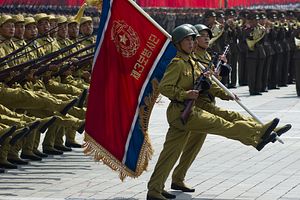Back in April 2012, North Korea paraded six KN-08 intercontinental ballistic missiles on top of a 16-wheeled transporter-erector-launcher (TEL). Some analysts immediately questioned whether the six Hwasong-13 (the North Korea name for the missile) were mockups (which turned out to be true). Various experts have also questioned whether the road-mobile KN-08 should in fact be classified as an ICBM at all, considering that there is no evidence that it is capable of breaching the 5,500-km threshold necessary to be labelled as such.
So what do we know about North Korea’s alleged new ICBM? The truth is very little except the following: The KN-08 is not an operational weapon, but a missile under development. Also, as the IHS Jane’s Intelligence Review underlines: “The existence of the KN-08 should not be conflated with a nuclear strike capability.”
According to satellite imagery, North Koreans tested the missile’s first stage engine in August 2014 at the Sohae launch site in North Korea’s northwestern Tongchang-ri region. This was preceded by a number of engine tests in 2013 and early 2014. Engine tests are stepping stones toward full-scale tests, but there is little hard intelligence on how well these tests went.
The next step is experimental flights tests, of which none so far seem to have occurred. An analyst written for IHS Jane’s Intelligence Review notes that, “it remains unlikely that it [North Korea] has successfully developed the three components required for a strike capability. These are a reliable long-range missile, a nuclear weapon small enough to be mounted on the missile, and a workable exoatmospheric re-entry vehicle.”
Back in October 2014, the Commanding General of U.S. Forces in South Korea, General Curtis Scaparrotti, emphasized that North Korea has not yet combined these three elements into a weapon system, which would pose a threat to the North American continent. Yet, he also noted: “They claim they have an intercontinental ballistic missile that’s capable [to do that]. I believe have the capability to have miniaturized a device at this point. I don’t believe that they have [done it so far]. They have the technology to potentially actually deliver what they say they have.”
According to GlobalSecurity.org, the KN-8 incorporates technology from various other missiles such as the Soviet SS-N-6, the DPRK’s No-dong-B, and the Soviet RSM-40 tankage and structures SLBM modified design, the RSM-50 and RSM-54 SLBM’s engines. A RAND Corporation report on North Korea’s missile program notes: “From an engineer’s perspective, the presented design is puzzling (H5). A KN-08 with SS-N-6 technology could off er intercontinental range, while the use of Nodong technology limits range to around 5,000 km.”
An additional factor for the KN-8’s final operational readiness will be, “Pyongyang’s ability to couple nuclear-tipped intermediate- or long-range missiles with road-mobile transporter-erector-launchers (TEL),” according to a previous analysis in The Diplomat. When deployed these TEL vehicles exit concealed bunkers to a cleared area, launch the missile, and then quickly retreat again to a secure location.
“We’re constantly aware of the threat’s evolution, including the KN-O8. And we constantly monitor other technologies that may feed the KN-O8 … And suffice it to say that we have effort underway to pace and stay ahead of the threat,” the director of the U.S. Missile Defense Agency Vice Adm. James Syring said at the beginning of this month.

































